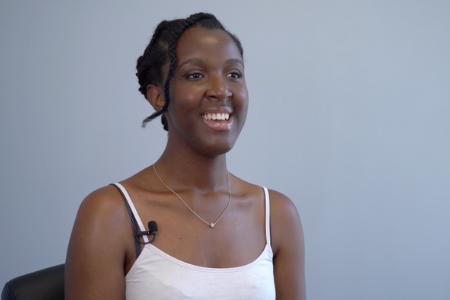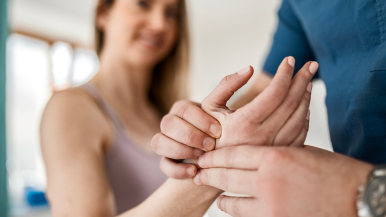- What is physical therapy?
- How does physical therapy help me heal?
- How can physical therapy help a car accident victim?
- What is it like to go to a physical therapy appointment?
Every 60 seconds in this country, someone is injured in a car accident. Sometimes, the injuries from car accidents are incredibly serious, leading to hospitalization and requiring intensive rehabilitation.
If your injuries following a traffic accident are serious, you may require a type of aftercare known as physical therapy to rehabilitate and regain your mobility. That’s exactly what happened to Adrienne J., a patient at Ability Rehabilitation. She experienced a serious car accident that left her in pain with mobility issues.
Adrienne says, “The one thing I couldn’t do before going through therapy was walking. I was rolled into this facility in a wheelchair. The last day of my physical therapy session I was walking out.” How does physical therapy help a patient like Adrienne recover after a serious car accident? Let’s talk about it.
What Is Physical Therapy?
Physical therapy is a healthcare treatment designed to lessen pain, improve strength and mobility, speed up healing, and improve the patient’s quality of life. This care is provided by a licensed health professional known as a physiotherapist or physical therapist. The treatment these professionals provide is in conjunction with the doctors and surgeons already working on your case.
Typically, physical therapy is the final step toward rehabilitation to regain your strength and health after serious injury or surgery. A physical therapist can design a treatment regimen plan that will help you reach your goals, whether they are increased mobility or a reduction in pain.
Adrienne says her goals were to “regain the independent lifestyle” that she enjoyed prior to her accident, including the mobility she once had taken for granted.
How Does Physical Therapy Help Me Heal?
 Physical therapy treatments can help with all kinds of physical ailments, helping the body improve and recover mobility by strengthening itself. Possible healing-related objectives of physical therapy include:
Physical therapy treatments can help with all kinds of physical ailments, helping the body improve and recover mobility by strengthening itself. Possible healing-related objectives of physical therapy include:
- Adapting to a prosthetic limb
- Helping the body learn to control the bladder and bowels
- Improving flexibility, movement, and strength
- Managing chronic diseases such as arthritis or diabetes
- Preventing surgery
- Rehab after accident, injury, stroke, or a surgery
- Relieving pain
- Working on balance to help reduce the risk of falls
The processes of physical therapy are suitable for all ages. It’s a great option for treating a whole host of health issues. Some of the typical treatments you may experience in your physical therapy sessions includes:
- Cold or heat application
- Guided exercises and stretches
- Massages on muscles or joints
- Rehab to help you walk with a prosthetic limb or assisted device
- Ultrasound to ease muscle spasms
- Weight lifting to strengthen specific muscle groups
- Whirlpool or warm water therapy
You also will likely have exercises to do at home in between therapy sessions to continue the work you’re doing and increase its effectiveness.
Another benefit of physical therapy is a guided approach to regaining strength. Adrienne says, “The biggest benefit I had with Ability was the mindset and the environment.” Your physical therapist will help you find the strength and determination you need to help you reach your goals for rehabilitation.
Adrienne continues, “I believe I already had the positive mindset to go in and come out stronger. Had it not been for the people and the encouragement that I got every time that I walked in, it would have dwindled or not been the same.”
How Can Physical Therapy Help a Car Accident Victim?
Physical therapy can help you regain all or some of the physical functionality you enjoyed before the accident occurred. Some of the treatments following a car accident include:
- Coordination and balance exercises designed to stabilize the body when standing, trying to sit, or walking
- Learning to use adaptive devices safely, such as crutches, walkers, or splints
- Passive exercises for your limbs if you cannot move them yourself
- Strength training and range of motion exercises for muscles weakened from the accident
- Retraining yourself to walk again, known as gait training, which teaches your body to move without exacerbating your injuries
Physical therapy after a car accident requires a treatment plan designed around neuromuscular re-education. Your body needs to remember how to function and become active again. You may need to learn workarounds to ensure your independence after severe or debilitating injury
The damage to soft and hard tissue following a car accident can be severe. Physical therapy can help you heal through the correct series of movements, which are coordinated with rest and other therapies.
What Is It Like to Go to a Physical Therapy Appointment?
 During your first physical therapy session, your provider will discuss your goals and go over your medical history. You’ll answer lots of questions about your pain, your symptoms, and your ability to move and function. Your physical therapist will likely administer a few tests to:
During your first physical therapy session, your provider will discuss your goals and go over your medical history. You’ll answer lots of questions about your pain, your symptoms, and your ability to move and function. Your physical therapist will likely administer a few tests to:
- Check your heart rate when exercising
- Determine your mobility, including how well you bend, grasp, reach, stand, and walk
- Observe your balance and posture
- See if you can climb stairs safely
Adrienne was pleasantly surprised by her first visit to Ability Rehabilitation. She says she was surprised by how the team focused on “getting to know my story and not just looking at my charts. They treated me like a person rather than a number.”
This is an important point. Your physical therapy treatment plan is designed for you as an individual. Every person heals differently and has different mobility challenges, particularly after a traumatic car accident like the one Adrienne experienced. Together with your physical therapist, you’ll work toward a goal by completing a treatment plan designed to give you a better quality of life.
Adrienne is just one example of the kind of work we do at Ability Rehabilitation. She, like many other patients, had never been to physical therapy before, so she entered the practice wondering what was next for her treatment. Once she arrived, she described being pleasantly surprised by the environment and treatment plan. She says, “My first impressions were: Okay, I think I can heal here.”



